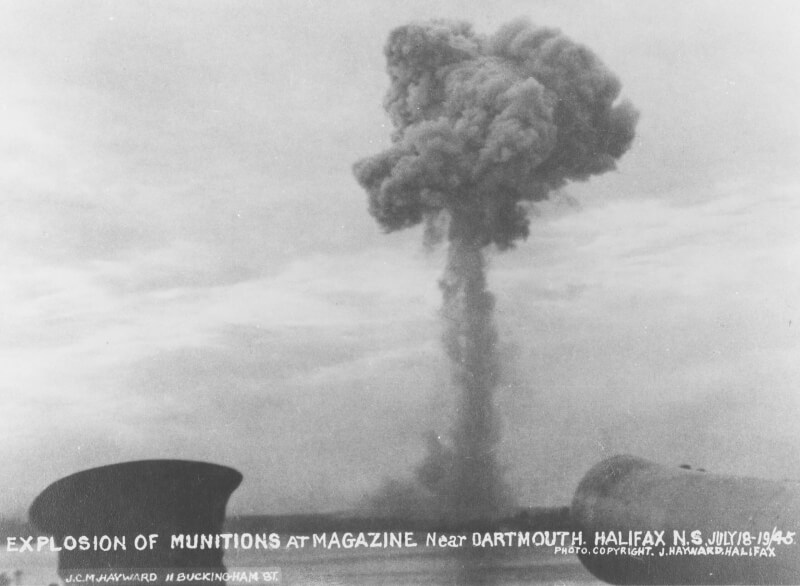
Blast cloud from Bedford Magazine Explosion.
[wikimedia]
The location broadly remained the same, although the circumstances were markedly different. Nevertheless, a degree of hubris could be attributed to both.
Back on that cold and unforgiving winter day, with the First World War having reached a fiery crescendo overseas, two vessels collided in Halifax Harbour. One, a heavily laden munitions ship, became the epicentre for the largest humanmade explosion before the atomic bomb detonations in Japan.
Hiroshima and Nagasaki hadn’t yet secured their dubious place in the history books by the mid-summer of 1945. In the meantime, the war in Europe had ended, affording some Canadian military personnel the chance to return home, either for release from the service or to be transferred to the Pacific theatre.
Halifax, long a strategically vital city bursting at the seams during periods of conflict, was more crowded than ever. In the aftermath of the infamous VE-Day riots, tensions between soldiers and civilians were also at their absolute highest. The port was indeed already a powder keg of sorts.
But on July 18, the explosive situation turned literal—again.

A crowd of people viewing broken glass outside Henry Birks & Sons Limited in Halifax. [wikimedia]
The issue, however, was a newly lax attitude toward regulations, the result of an accelerated disarmament process that could, in turn, facilitate swift discharges for surplus Royal Canadian Navy crews. Political convenience thus took precedence over proper procedure, with three vessels rather than one allowed to unload at a time.
A mass of shells, depth charges, torpedoes, pyrotechnics and other types of ammunition piled up in buildings and anywhere with space, including outside on the jetties. With the St. John’s, Nfld., Magazine having by then closed, its entire stock was transferred to Bedford, only adding to the volatile situation.
Worse, amid an intense heatwave, nearby grass, leaves and brush were bone-dry, brittle and flammable. It had the makings of a perfect firestorm.
The disaster-waiting-to-happen occurred around 6:30 p.m. that day, except the precise cause remains unclear. Was it a pyrotechnic flare that leaked and burst into flames? Was it a spark from a barge stove left burning? Did a careless soul flick a forbidden cigarette butt into the undergrowth-turned-kindling?
Despite great mystery and conjecture, the subsequent events are indisputable. Able Seaman Henry Craig, having spotted a fire raging on the south jetty, called to a mate, “I’m going down to see if I can put it out!” The Mosside, Ont., native had just reached the inferno when he became engulfed in an almighty explosion. Authorities found Craig’s body three days later, flung about 180 metres inland. He received a posthumous Mention in Dispatches for his valiant efforts.
Naval Patrolman Hill, having likewise witnessed the initial flames, telephoned in an alarm. The next thing he remembered was regaining consciousness on the other side of a fence approximately eight metres from his original position.
Commander Owen Robertson, the king’s harbourmaster, had just joined his wife for dinner at the Nova Scotian Hotel when “there was a bang and all of the dust came out of the ventilators.” He dashed to the top floor overlooking the water, where, to his horror, he saw “a mushroom cloud over the magazine!”
It was an all too familiar sight for residents who, still haunted by the Halifax Explosion—not yet 30 years earlier—believed history was repeating itself.
Thankfully, it wasn’t to be.
Canadian servicemen regained the trust they had partly lost during Halifax’s VE- Day riots.
A series of explosions sent red-hot metal shards into the sky over the coming hours, but neither the blasts nor falling debris claimed any additional lives. Shattered glass, a horrendous killer and maimer back in December 1917, had a limited impact the second time around. And while thousands of Halifax and Dartmouth civilians were evacuated, most individuals—if not quite all—returned to their homes intact, their lives largely unchanged.
In some respects, the July 18, 1945, incident reset relations between local citizens and the cities’ military inhabitants. Almost as soon as the explosion occurred, naval and municipal firefighters, co-ordinated by Commander Robertson once he arrived on the scene, responded to the blaze in the face of uncertain odds. Under an incessant barrage of flying shrapnel and bullets, the men—and one nurse treating wounds in situ—battled through the night.
They were joined by two fireboats, which hovered offshore pumping water into the inferno, and innumerable RCN volunteers who assisted where they could.
Whether bolstering efforts at the magazine or averting panic elsewhere in the cities, Canadian servicemen regained the trust they had partly lost during Halifax’s VE- Day riots.
The second Halifax explosion became little more than a footnote in history, but given the alternative, it was perhaps for the best.
Advertisement



















